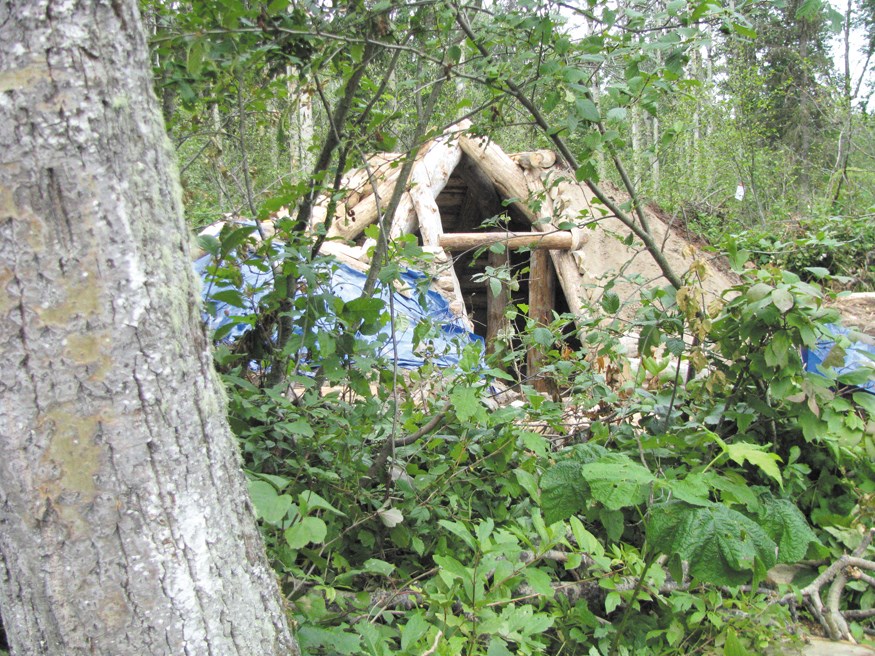For the first time in many generations, a pit house has been built on Lheidli T'enneh land.
Students from UNBC have put their backs as well as their brains into a summer First Nations Studies project. By the end of this week, by the sweat of their academic brows and with the permission of the Lheidli T'enneh First Nation (LTFN), a fully functional pit house will be newly constructed and operational. The students get course credit, the staff involved got project employment, and the elders involved got to bring their wisdom to life for future generations.
The pit house structure was once a staple winter shelter for Dakelh people all over the region, but colonial influences and modern times caused construction knowledge from being passed down from generation to generation as it had been for time immemorial. But it was, ironically, one white man's drawings from the 19th century that spanned the lost years.
The journals of Father Adrien-Gabriel Morice contained the blueprints for the construction project going on now on the Greenway Trail a few minutes into the bush alongside UNBC. Morice was renowned for his anthropological zeal, learning to speak the local Carrier language fluently and writing down the details of Carrier daily culture. Those field notes included sketches he made of pit houses. In short, a large hole is dug into the earth, poles are leaned into a cone over the hole in a teepee-style shape. The poles are roofed over with poles to form a solid ceiling, then the dirt removed during the dig is spread over the roof structure to create a weatherproof earthen final layer.
"My dad was going through Father Morice's stuff and came across the drawings," said Vince Prince, the leader of the course. "I've seen other ones built, but none that weren't engineered into place with cement and whatnot. We went right from the drawings."
The course organizers allowed for the use of modern hand tools like shovels and chainsaws, but the essential work had to be done by hand. The drawings indicated much smaller timber than what the course crew had available - beetle-killed pine wood found on the donated site - so modifications were made and new things learned by using full logs instead of poles.
"They learned a lot about physics, just to move them without breaking their backs," said teaching assistant Jennifer Pighin, who is learning her own culture through the course. Pighin is an acclaimed aboriginal artist and an elected LTFN band councillor. It's the second year in a row Pighin has been central to the course. Last year the task was to build and paddle a cottonwood dugout canoe.
Both of these hands-on summer courses were chiefly organized by UNBC professor Antonia Mills.
"Experiential learning is by farthe best," Mills said as she shucked bark from a pine log using a draw-knife. "I went through Harvard and all the rest [of her university programs] but I really didn't learn effective lessons until I was adopted by the Beaver clan [northeastern B.C.] in 1964. I visited Nak'azdli [the First Nation of Fort St. James] and saw the pit house Vince built there, so I asked him if he would take part in this course, he agreed," and the university, LTFN and other supporters like the Greenway Trail Society all supported the proposal.
Prince joked that his first one took more than a year and his second one took less than a month, with the 15 students and other helping hands. He also learned a lot more if he ever wants to build a third - a distinct possibility with all the community attention the project has caused.
"We're right on the Greenway Trail here so it's pretty visible, and that is part of the reasoning behind it," Prince said. "One lady walking by said 'oh, they're building a new Tim Hortons for the trail.' We wanted it close enough to the university that it would be easy to use for educational purposes or for people to come out on a short walk and take a close look at."
He also pointed out that this was not the usual place for a pit house. Normally they would be near a waterway, low in the valleys, on a gravel bed. But it was important to pick terrain like ancestral builders would have chosen, with a slight slope for carrying away runnoff and rain from the front door, and also avoid any steep hillsides behind that would put the house in the path of oncoming water.
"This clay has been hard to work with," he said. "It was six days of digging and you can tell they are university students because they calculated it all out. They weighed the loads then calculated the number of loads and estimated it was 4.2 tonnes they shoveled out. So we also call this the fit house project."
The little facility should be completed by Thursday with a public ceremony on Friday scheduled to begin at 11 a.m. to thank the elders, applaud the officials who funded and facilitated the course, and show the general public what winter homes in this area were like in the civilizations and societies of the area dating back thousands of years.



